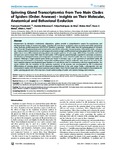Por favor, use este identificador para citar o enlazar este ítem:
http://www.alice.cnptia.embrapa.br/alice/handle/doc/902190Registro completo de metadatos
| Campo DC | Valor | Lengua/Idioma |
|---|---|---|
| dc.contributor.author | PROSDOCIMI, P | pt_BR |
| dc.contributor.author | BITTENCOURT, D. | pt_BR |
| dc.contributor.author | SILVA, F. R. da | pt_BR |
| dc.contributor.author | KIRST, M. | pt_BR |
| dc.contributor.author | MOTA, P. C. | pt_BR |
| dc.contributor.author | RECH, E. L. | pt_BR |
| dc.date.accessioned | 2013-04-02T23:33:43Z | - |
| dc.date.available | 2013-04-02T23:33:43Z | - |
| dc.date.created | 2011-10-04 | pt_BR |
| dc.date.issued | 2011 | pt_BR |
| dc.identifier.citation | Plos One, San Francisco, v. 6, n. 6, p. 1-15, June 2011. | pt_BR |
| dc.identifier.uri | http://www.alice.cnptia.embrapa.br/alice/handle/doc/902190 | pt_BR |
| dc.description | Characterized by distinctive evolutionary adaptations, spiders provide a comprehensive system for evolutionary and developmental studies of anatomical organs, including silk and venom production. Here we performed cDNA sequencing using massively parallel sequencers (454 GS-FLX Titanium) to generate ~80,000 reads from the spinning gland of Actinopus spp. (infraorder: Mygalomorphae) and Gasteracantha cancriformis (infraorder: Araneomorphae, Orbiculariae clade). Actinopus spp. retains primitive characteristics on web usage and presents a single undifferentiated spinning gland while the orbiculariae spiders have seven differentiated spinning glands and complex patterns of web usage. MIRA, Celera Assembler and CAP3 software were used to cluster NGS reads for each spider. CAP3 unigenes passed through a pipeline for automatic annotation, classification by biological function, and comparative transcriptomics. Genes related to spider silks were manually curated and analyzed. Although a single spidroin gene family was found in Actinopus spp., a vast repertoire of specialized spider silk proteins was encountered in orbiculariae. Astacin-like metalloproteases (meprin subfamily) were shown to be some of the most sampled unigenes and duplicated gene families in G. cancriformis since its evolutionary split from mygalomorphs. Our results confirm that the evolution of the molecular repertoire of silk proteins was accompanied by the (i) anatomical differentiation of spinning glands and (ii) behavioral complexification in the web usage. Finally, a phylogenetic tree was constructed to cluster most of the known spidroins in gene clades. This is the first large-scale, multi-organism transcriptome for spider spinning glands and a first step into a broad understanding of spider web systems biology and evolution. | pt_BR |
| dc.language.iso | eng | eng |
| dc.rights | openAccess | eng |
| dc.subject | Sequencia de DNA | pt_BR |
| dc.subject | Sequenciamento | pt_BR |
| dc.subject | Aranhas | pt_BR |
| dc.title | Spinning gland transcriptomics from two main Clades of Spiders (Order: Araneae) - insights on their molecular, anatomical and behavioral evolution. | pt_BR |
| dc.type | Artigo de periódico | pt_BR |
| dc.date.updated | 2013-04-02T23:33:43Z | pt_BR |
| dc.subject.nalthesaurus | Sequence analysis | pt_BR |
| dc.subject.nalthesaurus | Araneae | pt_BR |
| dc.subject.nalthesaurus | Transcriptomics | pt_BR |
| riaa.ainfo.id | 902190 | pt_BR |
| riaa.ainfo.lastupdate | 2013-04-02 | pt_BR |
| dc.identifier.doi | 10.1371/journal.pone.0021634 | pt_BR |
| dc.contributor.institution | FRANCISCO PROSDOCIMI, UFRJ, UCB; DANIELA MATIAS DE C BITTENCOURT, CPAA; FELIPE RODRIGUES DA SILVA, CNPTIA; MATIAS KIRST, University of Florida; PAULO C. MOTA, UnB; ELIBIO LEOPOLDO RECH FILHO, CENARGEN. | pt_BR |
| Aparece en las colecciones: | Artigo em periódico indexado (CNPTIA)  | |
Ficheros en este ítem:
| Fichero | Descripción | Tamaño | Formato | |
|---|---|---|---|---|
| spinningjournal.pone.0021634.pdf | 1.11 MB | Adobe PDF |  Visualizar/Abrir |









